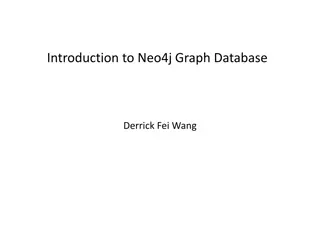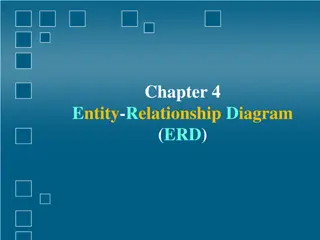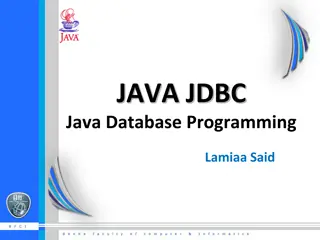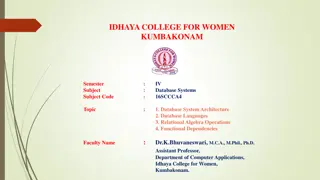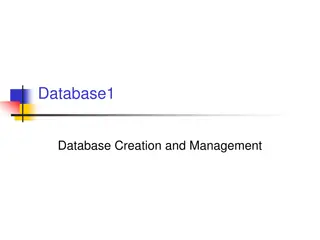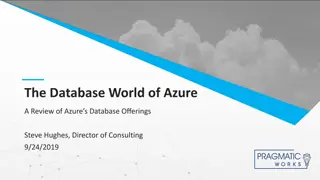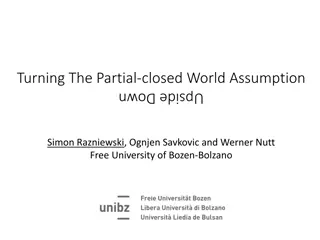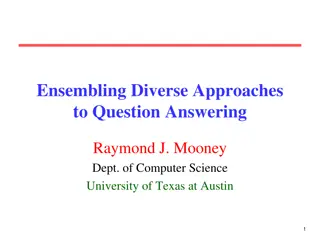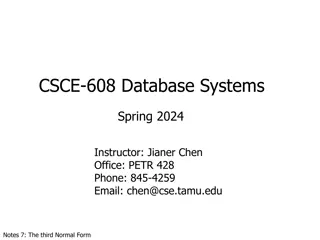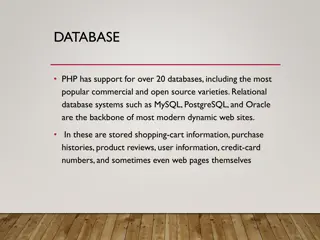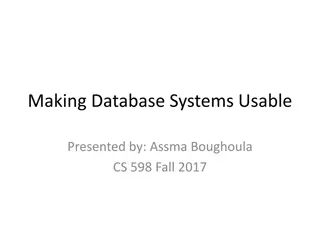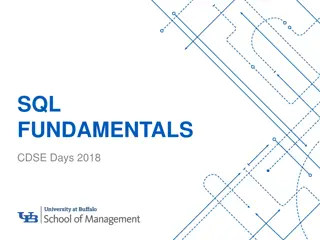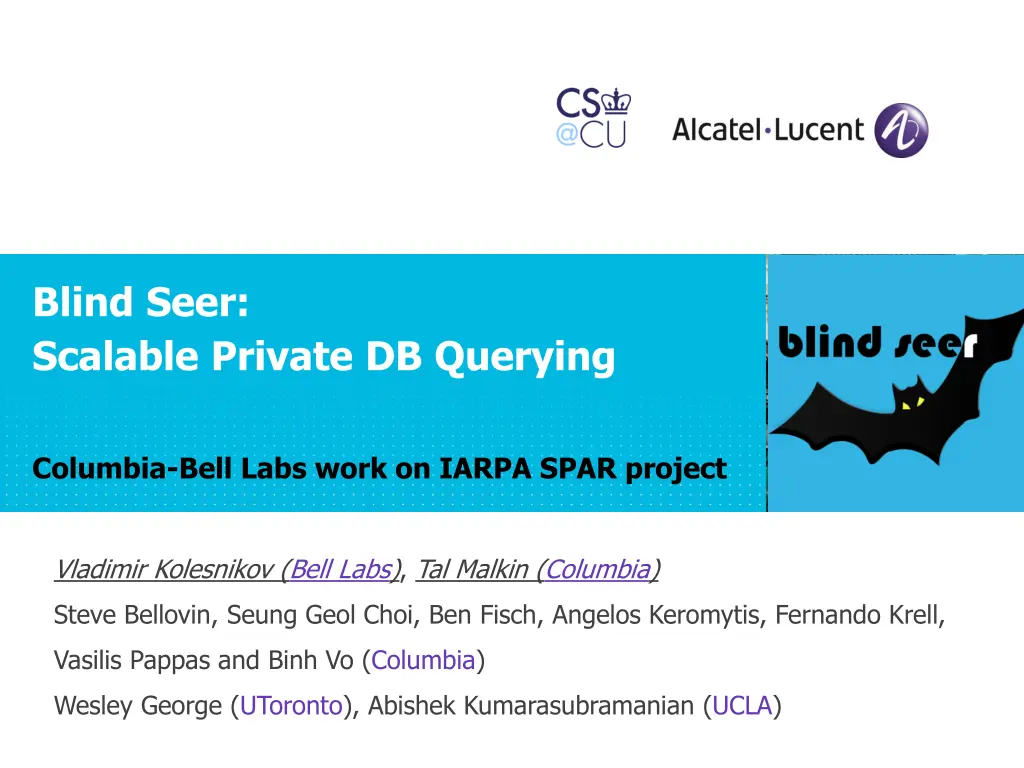
Scalable Private Database Querying Project
Explore the Blind Seer project, a collaboration between Columbia and Bell Labs under the IARPA SPAR program. The project addresses privacy concerns in database querying, with a focus on security tradeoffs and innovative approaches. Key features and requirements, as well as the fundamental system architecture, are highlighted. Discover how Blind Seer aims to enhance the state of the art in secure function evaluation, offering insights into preserving data privacy while enabling robust query support. Dive into the challenges of achieving secure requirements and the importance of controlled leakage for meaningful security tradeoffs.
Download Presentation

Please find below an Image/Link to download the presentation.
The content on the website is provided AS IS for your information and personal use only. It may not be sold, licensed, or shared on other websites without obtaining consent from the author. If you encounter any issues during the download, it is possible that the publisher has removed the file from their server.
You are allowed to download the files provided on this website for personal or commercial use, subject to the condition that they are used lawfully. All files are the property of their respective owners.
The content on the website is provided AS IS for your information and personal use only. It may not be sold, licensed, or shared on other websites without obtaining consent from the author.
E N D
Presentation Transcript
Blind Seer: Scalable Private DB Querying Columbia-Bell Labs work on IARPA SPAR project Vladimir Kolesnikov (Bell Labs), Tal Malkin (Columbia) Steve Bellovin, Seung Geol Choi, Ben Fisch, Angelos Keromytis, Fernando Krell, Vasilis Pappas and Binh Vo (Columbia) Wesley George (UToronto), Abishek Kumarasubramanian (UCLA)
Outline Project Basic system architecture (Tal) Basic approach (Tal) Additional features Protection against malicious players Other interesting issues/solutions 2
IARPA SPAR Program Tim Edgar mentioned the origins of IARPA SPAR Result of ODNI asking itself the question of privacy? There exists Deputy for Civil Liberties for the Director of National Intelligence 3
This Project Solves specific problem Improves/clarifies state of the art of large GC- based SFE. Basic approach to appear in Oakland 2014 Pappas, Krell, Vo, Kolesnikov, Malkin, George, Keromytis, Bellovin, Blind Seer: A Scalable Private DBMS 4
Required features 100M records, 10TB DB Preserve query and data privacy Allowed up to 2-10x overhead compared to MySQL Robust query support: select * where NAME=Bob AND AGE >20 Boolean query expressions (including at least three conjunctions) Range queries and inequalities for integer numeric, date/time, etc Matching of keywords close to a specified value (stemming) Text fields with many keywords (e.g. 100 s) Matching of values with wildcards Matching of values with a specified subsequence m-of-n conjunctions Ranking of results 5
Blind Seer: The Basics Requirements are very hard to achieve securely (impossible ?) must relax security guarantees Challenge: How? Find a right TRADEOFF - meaningful, reasonable, provable security (controlled leakage) - Lots of interesting research to be done How much leakage is too much? How do you evaluate the damage of a certain leakage profile? How do you qualify/quantify how good your tradeoff is? Application specific? Is there a formal way to do so? I will describe Our basic system and approach: - Touch upon some of our tradeoffs - Focus on Boolean queries, semi-honest parties - Skip a whole lot (Vlad will touch on some of it) 6
Secure Computation: Yaos GC AND AND Alice s inputs Bob s inputs NOT AND OR OR Very fast for small problems, but doesn t scale to large circuits How to scale? Identify privacy-critical subroutines and implement securely Insecure implementation of the rest Challenge: Understand and formalize security guarantees (hard problem) 8
Bloom Filter Constant-time querying Efficient storage (ca 10 bits per keyword) Fixed access pattern (same for both match and non-match) Encrypted BF: Same as BF, but objects are encrypted need deterministic encryption 9
Occluded BF Query: C sends Enc(kw), S computes match OK for single keyword searches For formulas, need to hide terms matching Idea: Mask BF with a (pseudo-)random pad Let Client know the pad (via seed) Then Client and Server run SFE for computing match, where C inputs pad. GC is very efficient: 10-20 gates per term, plus gates to implement formula. 10 | Columbia U / Bell Labs
Search Tree DB records 2 1,4 3 4 1,8 5 5 5 5,6 6 6 6 5,8 7 7 7 7,8 8 8 8 11 | Columbia U / Bell Labs
Search Example DB records 2 1,4 3 YES 4 1,8 5 5 5 5,6 6 6 6 5,8 7 7 7 7,8 8 8 8 12 | Columbia U / Bell Labs
Search Example DB records 2 YES 1,4 3 YES 4 1,8 5 5 5 5,6 6 6 6 5,8 NO 7 7 7 7,8 8 8 8 13 | Columbia U / Bell Labs
Search Example DB records 2 YES 1,4 3 YES 4 1,8 5 5 5 5,6 6 6 6 5,8 NO 7 7 7 7,8 8 8 8 14 | Columbia U / Bell Labs
Search Example DB records NO 2 YES 1,4 3 YES 4 YES 1,8 5 5 5 5,6 6 6 6 5,8 NO 7 7 7 7,8 8 8 8 15 | Columbia U / Bell Labs
Search Example DB records NO 2 YES YES 1,4 3 YES 3 YES YES 1,8 5 5 5 5,6 6 6 6 5,8 NO 7 7 7 7,8 8 8 8 16 | Columbia U / Bell Labs
What is Leaked ? Query Pattern (e.g., S can distinguish between simple and complex queries, may learn about repeated terms in different queries) Returned Records Access Pattern Tree search pattern of each query: 17
What is Leaked ? Query Pattern (e.g., S can distinguish between simple and complex queries, may learn about repeated terms in different queries) Returned Records Access Pattern Tree search pattern of each query: 1-8 1-4 5-8 1-2 3-4 5-6 7-8 7 8 3 4 5 6 1 2 18
What does this mean? OR queries: Only leakage is access patterns (tree traversal can be simulated, no leakage on individual terms) Efficiency proportional to number of results (asymptotically optimal) AND queries: Tree search pattern reveals more: also abandoned paths Efficiency: at most proportional to number of matches for best term (asymptotically optimal??) Similar to MySQL, but don t need to know which term is best Abandoned paths (leakage, run time) depend on data and query (and randomness of tree construction). Seems inherent for sublinear computation (work in progress) 19
Arbitrary Boolean Formulas Efficiency: at most proportional to number of matches of BEST term in CNF decomposition of formula (don t need to know it) Leakage: access pattern and tree search pattern - Hard to quantify but much less than giving information on patterns of individual terms in the formula (no information on plaintext beyond patterns) 20
0-1 Result Set Size Indistinguishability Goal: hide from S whether there was a 0 or 1 match. S is an airline and C is gov t querying for POI. Expect 0 hits S learning of a match can cause panic. Def 1: Consider probability of bad event, prove it s small Def 2: If distinguishable, guarantee that D s confidence is not very high
0-1 Result Set Size Indistinguishability Goal: hide from S whether there was a 0 or 1 match. Def 2: If distinguishable, guarantee that D s confidence is not very high - if the a-priori probability of a 1-case is ?, then conditioned on any possible view, the a-posteriori probability of a 1-case is at most (1 + ?)?). Solution: C adds p of fake tree-traversal paths. p is a random variable drawn from distribution like this N paths Theorem: Above solution satisfies Def. 2 with ?=1
Optimizations Parallelization Na ve parallelizing multiple queries Demonstrated up to 5x throughput benefit More intelligent speedup intra-query Tree traversal is the most expensive step Node visits are mostly independent, and thus highly amenable to parallelization In 16-core setup observed 16x improvement for traversal. 27
Optimizations Better BF analysis Currently 10^-6 false positive rate in all tree nodes Much smaller FP rate is sufficient to achieve total 10^-6 BF FP are good for security: Creates noise in tree traversal patterns With 10^-3 FP, # circuit inputs is cut in half, and hence expect approx factor 2 performance improvement. Observed about 50% improvement 28
Optimizations Faster secure computation with GESS (vs garbled circuit) Kolesnikov-Kumaresan (SCN 2012) Approx 3x improvement in bandwidth vs best GC Greatly improves performance on narrow channels Working on translating this into speed improvement on fast LAN. Observed about 50% improvement in experiments Did not integrate into current code so far 29
Optimizations Code optimization Possibly most important for performance but effort-intensive Interplay of LAN, caching, threads, RAM access Plugging in improved OT extension code of ALSZ13 (CCS 2013) and Kolesnikov-Kumaresan13 (Crypto 2013) Factor 3 improvement in OT => factor 1.5-2 overall (?) Conflicted with the multithreaded libraries we used; Did not integrate in our code 30
Why Rebuilding Resource utilization (preprocessing phase) 32
Search Tree Rebuilding Use two Index Server boxes and switch between them Algorithm - Same as preprocessing algorithm with fresh randomness - No re encryption of records needed Really fast - RAM-only computation Efficiency - Only the bloom filter index tree is rebuilt - Takes about 20 min to generate and transfer (vs 1-3 days of full DB init) Security across rebuilds - Tree traversal information learnt by the client/IS is much less useful. - IS now sees new BFs with new hash fcns. 34
Policy Compliance GC is strategically at the center of our approach because easy to compose. Requirement: secure policy checking: Policy rejection should look like a query no-match to C and S implement policy as a GC computation whose output is an input to BF tree node GC computation. 35
Malicious Client Protection Guarantee (roughly): Actively cheating client cannot receive DB rows if the query is unauthorized. Idea: GC is secure against malicious evaluator. Have IS generate the garbled circuit 36
Malicious Client Secure policy enforcement and database privacy against maliciously behaving clients who may arbitrarily deviate from protocol Why malicious? So far, - Query sent to the Query Checker which enforces policy can be completely different from the query sent to the Index Server - Client can change his decryption mask at will 37
Client Changing his mask Recall: We have Encrypted BF Decryption Key is with the client What if a Client changes it? 38
Client changing his mask We provide analysis that asymptotically, a client changing his mask is not likely to succeed with sufficiently small probability BF uses 30 bits per keyword and 20 hash functions The average density of a bloom filter is about 1/2 with the false positive rate of 10^-6. There are tons of zeros when a keyword does not match Flipping a random false negative involves correctly identifying a subset of size some c fraction (with c > 0 a constant) to flip. -> negligible probability (in number of BF bits used) 39
Malicious behavior in OT/Circuit generation Index Server Big potential for cheating Client Query For results Query Checker Client Query For Check Client 40
Malicious behavior in OT/Circuit generation Client does not learn the output of either the policy Or the result. Learns only garbled output Index Server Garbled Universal Circuit (KS08) Information to Synchronize keys Query Checker Garbled Query Check Circuit Client 41
(Malicious.. ) Universal Circuit IS generates universal circuit which evaluates any circuit on any input. Circuit has a fixed tree pattern. The gates and inputs are unknown and provided by the client and IS AND of policy check circuit and universal circuit performed Inputs to PC and Evalualtion Circuits are cryptographically binded. 42
UC is cheap If g is 0 (OR gate). then you have b_1 OR b_2 If g is 1 (AND gate), then you have NOT(NOT b_1 OR NOT b_2) = b_1 AND b_2 One non-XOR gate! (XOR gates are free KS08a) 44
Audits With the client s help - Client can reveal his query and entire randomness - Client cannot fool an auditor by revealing wrong randomness Without the client s help - Combine transcripts of S/IS/QC reveal most or all of client s query - Bloom filter indices are derived based on hash values of the client query - Can convert hash value to an AES encryption and derive the indices from that - Server can decrypt any transcript to reveal query terms 45
Practical circuit for MPC Unfinished search for MPC benchmark Beets auction (private circuit?) AES, DES, Mult, etc. Not clear how useful in practical MPC The SPAR Circuit We give you Tree Pairs of leaves XOR together and then form AND subtrees to evaluate BF Output of this is fed into the query formula Usually just a couple of ANDs; a log-domain OR for range or negations. 46

